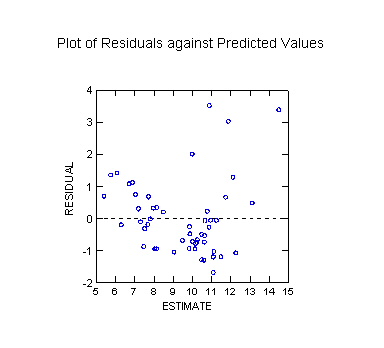
Second, use the file of residuals, go to the npar (nonparametric statistics) module, and do the runs test. A significant result indicates that the residuals are correlated
>USE
"D:\mydocs\ys209\divorce.syd"
SYSTAT
Rectangular file D:\mydocs\ys209\divorce.syd,
created
Wed Apr 19, 2000 at 00:25:57, contains variables:
YEAR
DIVPOP DIVMF
UNEMP FLFPRT
MARUMF
TREND
First do the regression and save the residuals (repeat).
>mglh
>select
year <= 1970
>model
divmf=constant+unemp+flfprt+marumf
>save
divres01/data
>estimate
Data
for the following results were selected according to:
year <= 1970
Dep
Var: DIVMF N: 51 Multiple R: 0.866237
Squared multiple R: 0.750366
Adjusted
squared multiple R: 0.734432 Standard error of estimate: 1.206846
Effect
Coefficient Std Error Std Coef
Tolerance t P(2 Tail)
CONSTANT
-9.243243 2.117510 0.000000
. -4.36515 0.00007
UNEMP
0.047519 0.035985 0.125499
0.588047 1.32052 0.19306
FLFPRT
0.239771 0.029453 0.672784
0.777664 8.14082 0.00000
MARUMF
0.137210 0.019332 0.606853
0.726515 7.09745 0.00000
Analysis of Variance
Source
Sum-of-Squares df Mean-Square
F-ratio P
Regression
205.764749 3 68.588250
47.091854 0.000000
Residual
68.454466 47 1.456478
***
WARNING ***
Case
26 is an outlier (Studentized
Residual = 3.239025)
Case
27 has large leverage (Leverage = 0.347000)
Case
27 is an outlier (Studentized
Residual = 3.955823)
Durbin-Watson
D Statistic 0.429
First
Order Autocorrelation 0.711
Residuals
have been saved.
-------------------------------------------------------------------------------
Plot of Residuals against Predicted Values

Second,
use the file of residuals, go to the npar (nonparametric statistics) module,
and do the runs test. A significant result indicates that the residuals
are correlated
>use divres01
SYSTAT
Rectangular file d:\mydocs\ys209\divres01.SYD,
created
Wed Apr 26, 2000 at 13:29:59, contains variables:
ESTIMATE
RESIDUAL LEVERAGE COOK
STUDENT SEPRED
YEAR
DIVPOP DIVMF
UNEMP FLFPRT
MARUMF
TREND
>npar
>runs
residual
Wald-Wolfowitz
runs test using cutpoint = 0.000
Probability
Variable
Cases LE Cut Cases GT Cut Runs
Z
(2-tail)
RESIDUAL
32 19
8 -5.103269
0.000000
Thus one concludes that the residuals in this case are correlated.